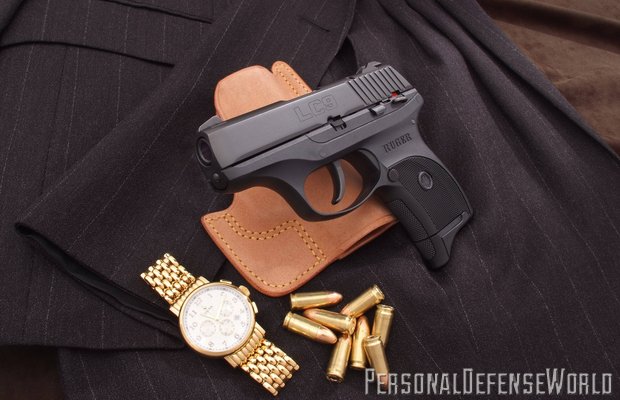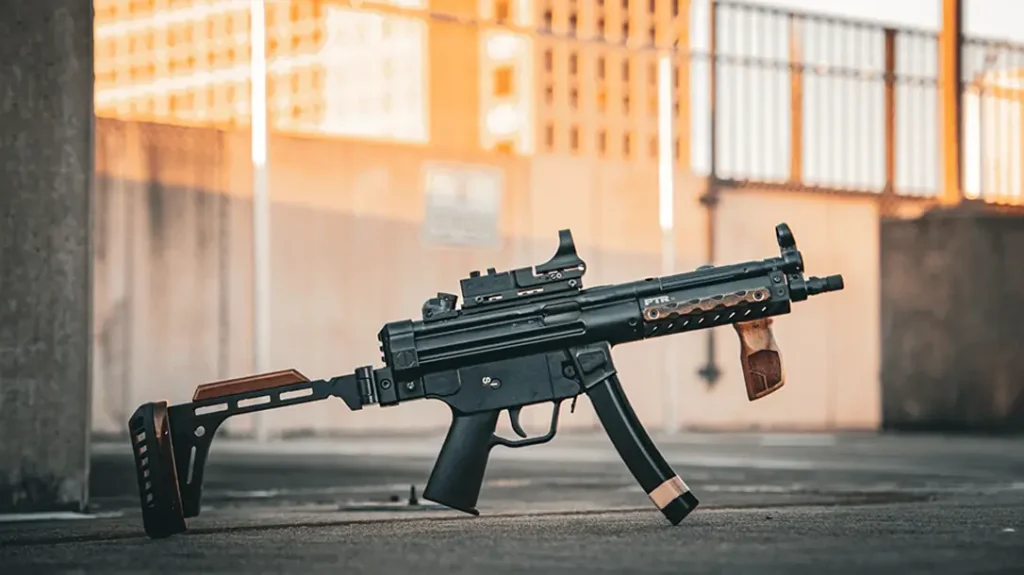Deciding on a concealed carry weapon is often fraught with compromises, either in terms of size or cartridge capacity, weight or means of carry. Today, the favored gun for concealment is the subcompact .380. The .380 offers many advantages, despite its smaller 9mm caliber and average 6+1 capacity. The best case would be a semi-auto the size of a .380 but chambered for the more powerful 9mm cartridge. And better still would be a gun with a full 7+1 capacity. Wishful thinking only a couple of years ago, Ruger has made all of this a reality with the new LC9 (Light Compact 9mm) pistol.
Gun Details
The LC9 is based on the highly successful Ruger LCP .380, only in a slightly larger package with several additional features that make the 9mm version a very competent sidearm for both law enforcement and civilian use. The LC9 offers compact dimensions (6 by 4.5 by 0.9 inches) combined with a comparatively high capacity of 8 rounds (7+1), and light carry weight of just 17.1 ounces empty (21.5 ounces with 8 rounds). The LC9 is built with a composite frame of high-performance glass-filled nylon supported by an aluminum grip frame, a through-hardened steel slide, and 3.12-inch steel barrel. It is a combination of durable synthetic materials and steel components that have already proven themselves in the .380 LCP since its introduction in 2008.
Advertisement — Continue Reading Below
The strength of the glass-filled nylon frame and its well-designed contouring render a gun that ideally fits the average hand, placing the trigger finger directly alongside the triggerguard with a natural recess for the first joint to rest before moving to engage the trigger. On the left side, the contoured grip frame places the thumb in an ideal position for a single-handed hold, or to be supported by the off-hand thumb for a rock solid two-handed grip. As an added safety measure, the LC9 has a loaded chamber indicator that rises upward from the top of the slide. It is clearly marked in red and the top is stamped “LOADED WHEN UP.” There is an external (key set) locking system that renders the gun inoperable for storage. The same key is used to remove the takedown pin for field-stripping/cleaning, and to change magazine floorplates.
The LC9 is well balanced but slightly muzzle-heavy, an asset in helping to diminish recoil with standard 115-grain 9mm FMJ loads. An elongated (oval) triggerguard leaves ample room to move in and out of engagement with the trigger, which has exceptionally long travel. This is a function of both safety and the nature of the LC9’s internal hammer design, which requires a longer stroke to cycle than a striker-fired semi-auto. Simply stated, discharging the Ruger is like firing a DAO revolver with a shrouded hammer.
One of the biggest advantages of the LC9 is the addition of adjustable, dovetailed three-dot sights. The taller, easily acquired white dot sights add 0.18 inches to the overall height of the gun, plus edged surfaces that can potentially snag on fabric during a pocket draw, but the tradeoff seems well worthwhile for improved sighting. The grip side panels, backstrap and frontstrap all have fine diamond checkering molded in, as does the front of the magazine floorplate extension. The extension adds further stability, though at the cost of some concealment capability.
Advertisement — Continue Reading Below
Carry Rigs
Fortunately for potential LC9 owners, the Ruger’s dimensions are nearly identical to the Kahr PM9, so every holster that fits the Kahr fits the LC9. For our test, we selected three different methods of carry. First was the Galco Ambidextrous model PH460 Front Pocket Horsehide holster. This is a contoured rig that keeps the gun’s profile suitably minimized in a dress trouser pocket and does a good job even in a closer-fitting pair of jeans. The rough exterior and lower pocket-hook profile keep the LC9 upright and centered for an easy draw. The nicely burnished pouch is also rigid enough to allow re-holstering in the pocket without much fuss. Being suitable for either strong- or off-side carry, the Galco rig makes the Ruger a double threat for concealment. For pocket carry, the gun works best with the short floorplate installed on the magazine.
We also experimented with the innovative new Bianchi International 101. The flat, contoured 101 is half a holster, and is designed to make the wearer’s belt the back half. This allows the 101 to be used in a variety of positions around the waist. The gun slides down and rests firmly against the waist and is still easy to draw from concealment. This is by far the closest you can come to minimizing a holster and still be using one!
Advertisement — Continue Reading Below
Our third concealed carry holster was another minimalist rig, the Galco Jak Slide, originated way back when by the “The Famous Jackass Leather Company.” The Jak Slide carries the LC9 between the belt and the pants with the belt passing through slots on the front side of the holster pouch. This pulls the pistol in close to the body for maximum concealment but leaves plenty of LC9 grip to grab for a clean draw.
All three concealed carry methods worked ideally with the Ruger 9mm’s compact dimensions. It is not too much gun for pocket carry but works extremely well with a dedicated belt holster.
Shooting Impressions
Advertisement — Continue Reading Below
Being familiar with the Ruger LCP as a personal carry gun for over three years, stepping up to the slightly larger and significantly more powerful 9mm LC9 was almost second nature. The feel is very much the same, just a bit more hand filling, which is a good thing. With the extended magazine floorplate (finger extension) attached, the gun feels very well-balanced in the hand. With the short floorplate attached (which eliminates the small finger rest) the gun falls well into hand with the little finger resting under the magazine. Noticeably improved over the LCP are the three-dot sights, which are easy to acquire under almost any lighting conditions. This single advantage makes the LC9 a very precise gun to fire compared to subcompacts with smaller, non-adjustable and often barely visible sights.
The size, weight and feel of the LC9 leave you wanting for nothing more. And while the trigger pull is exceptionally long, 1.125 inches, 0.25 inches of which is used to stage the trigger, the remaining 0.87 inches of pull is smooth and very consistent, allowing for quick follow-up shots. Trigger pull on our test gun averaged 7.4 pounds. With very little practice, it is possible to learn to stage the trigger for timed-fire target shooting. Since the internal hammer can be clearly seen from the rear, this is also a visual check. If a round is not chambered, the hammer cannot be seen. Recoil with every type of ammo tested remained very linear with modest muzzle rise. The only difficulty we found was smooth operation of the manual safety, which is comparatively easy to release but hard to set because it is hinged at the front. Once set, only modest thumb pressure is needed to drop the LC9’s safety on the draw. A slightly longer safety lever would alleviate this minor issue and will probably be among the first aftermarket products for the LC9, aside from holsters and the new Crimson Trace Laserguard.
With a full magazine inserted, the slide only requires a modest pull to the rear to release and bring the gun into battery from the locked back position. The slide release itself is another small lever that takes more than average effort to activate and requires the slide to be drawn slightly to the rear in order to activate, thus eliminating the possibility of single-hand operation on the reload—the only true weakness in the entire design. One could push the leading edge of the slide against a solid surface—a table edge or the heel of a shoe—if single-handed operation were an absolute necessity.
Advertisement — Continue Reading Below
Test ammunition was Hornady Critical Defense 115-grain FTX, Federal American Eagle 115-grain FMJ and Sellier & Bellot 115-grain FMJ. The three brands clocked close together on the ProChrono chronograph; 1,035 fps (feet per second) for the Hornady, 1,045 fps for the American Eagle and 1,050 fps for the S&B. Of the three brands, the LC9 showed a distinct distaste for the Sellier & Bellot, with multiple failures to fire and eject. After half a dozen misfires out of 50 rounds, I withdrew the S&B from the test. There were no misfires or failures with American Eagle or Hornady. This is actually the first time I had encountered this with Sellier & Bellot ammunition, which has been consistently good ammunition though lower priced.
Two tests were done, one at 25 feet and one at 50 feet, both using a two-hand hold and Weaver stance. All shots were time-fired at 1-second intervals, fired off-hand.
The best five-round group fired at a B-27 silhouette target from a measured distance of 25 feet was from Federal American Eagle, which placed all shots within the X-ring at a maximum of 2 inches center-to-center. At a quarter-inch wider, Hornady FTX placed its best five rounds (fired at a white circle drawn over the 9-ring) within a distance of 2.25 inches. The Sellier & Bellot had the greatest spread at 3.75 inches, though two were in the X-ring, two overlapped in the 9-ring at 2 o’clock, and one flyer landed at the bottom of the 9-ring. At a measured distance of 50 feet using a Score Keeper 50 Feet Slowfire target, the LC9 placed five Hornady FTX at 2.75 inches and the same with five American Eagle 115-grain 9mm rounds. All would have been central body mass hits on the B-27 silhouette.
Advertisement — Continue Reading Below
Unlike the LCR, the slide on the LC9 locks back after the last shot, a definite advantage if you’re not counting. The magazine release on the LC9 is angled up toward the strong-hand thumb, allowing an easy release to drop the empty magazine and reload. While the general contours of the gun are ambidextrous, the manual safety, slide and magazine release are not.
Final Notes
While no gun is perfect for every situation, the best compromise we have seen thus far comes in a package called the LC9, a gun that offers compact dimensions, light weight, excellent frame contours for either a single- or double-handed grip, and a full capacity of 7+1 rounds of 9mm. At $443, it is more gun than anyone can reasonably expect for the price. The LC9 will quickly follow in the .380 LCP’s footsteps as a consummate 9mm concealed carry sidearm.
Advertisement — Continue Reading Below























